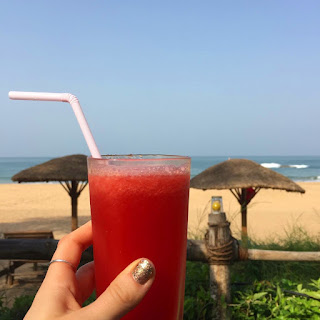Staring out at the ocean with a fresh watermelon juice in one hand and a book in the other, I felt a million miles from home. And yet I didn't feel I was in India.
Having landed in Goa late the previous evening, we'd had little chance yet to explore and so far the only Indians I'd encountered on Agonda Beach had four legs and an udder. After the cows, the second largest population is undoubtedly the Europeans so whilst I'd heard plenty of exotic Italian, French and Swedish accents, I'd barely heard a whisper of Konkani.
It perhaps didn't help that the book in my hand that morning was Shantaram, a true account of a man living in a slum in Bombay, from which I could draw no comparison. However, even without this extremity in mind, the rooms were pristine, the service too timely and there were as many British options on the menus as Indian. Who comes all the way to India to have a Full English Breakfast?
Fortunately, we found a handful of restaurants a little way down the beach offering authentic local food where we indulged in an okra masala and vegetable kadai with lemon rice, raita and plain roti. This quite literally gave us a taste of the real India so as soon as we'd paid the bill (a grand total of 300 rupee- the equivalent of £3) we headed out in search of more.
'There, Palolem.'
We were dropped at the side of a dusty road by a man in a green and yellow Tuk Tuk who's name I didn't catch, though I asked three times. Not yet shed of my British mindset, I nodded and smiled rather than asking for a fourth.
At his fingertip was a narrow path between a cluster of trees which presumably led to Palolem, another Goan beach which we'd been told was more alive with locals.
The path appeared to pierce through the middle of a dumping ground with huge scraps of metal, rope and broken wood piled between the shrubbery. It took me a long while to realise these were homes. Each was surrounded by a bed of more rubbish; plastic bottles, cans, wrappers and rags, which seemingly housed the camp's pet pigs, as well as some other less welcome guests.
At closer inspection, we noticed further small huts concealed beneath the camouflaging leaves which constituted the slanted rooftops. They were more like tents than houses, too low for even the smallest of children to stand up in and yet would likely have to suffice for a family of six to sleep.
Others stood taller but none stood strong - certainly not stable enough to withstand the oncoming monsoons of next month. Ravi, the young boy who'd brought us from the airport to Agonda, had told us the rains inflict such destruction that even our guesthouse is forced to close and rebuild their entire property the following season.
The contrast between this small community and the beach the other side was quite shocking. Palolem wreaked of perfection. There wasn't a drop of littler spoiling the golden sand, nor one sign of the poverty we'd just emerged from.
Bars, cafes and small shops formed a definitive divide between the two so nobody need know what lies behind. It was clear that Palolem would offer no more of India than Agonda had but we decided to stay and at least watch the sunset from this beautiful spot.
Whilst we waited, we were joined by two Indian women who introduced themselves as Stephanie and Surita and sat down beside us. From our short conversation with them, I learnt more about this country than I had in the twenty-four hours we'd spent in it. It was at that moment I decided to document this trip through the people we meet as well as the places we visit. I believe it will give a more accurate representation and it all starts with Stephanie and Surita.







No comments:
Post a Comment